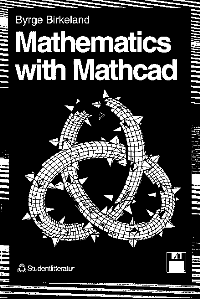Volume 12, Issue 1, 1998

Book Review:
Byrge Birkeland (1997),
"Mathematics with Mathcad",
Studentlitteratur.
- Simon Mardle
- University of Portsmouth
As the title suggests, ‘Mathematics with Mathcad’ (MwM) is designed to aid mathematics interpretation and solution through the power and usability of Mathcad (see Murphy (1996a), (1996b) for recent Mathcad reviews). This capability is partly shown by the book itself, which is written entirely in Mathcad, including a wide range of mathematical topics involving substantial equations, graphics and text. Short examples relevant to each topic are demonstrated, the contents including sections on algebra, logic sets and numbers, linear algebra, geometry and trigonometry, calculus, differential equations, numerical mathematics, and probability and statistics.
The book is comprehensive, covering many of the areas in mathematics that a student of any discipline will encounter during their undergraduate degree course. The content is good but slightly clumsy in areas. For example, the section on the simplex method is quite different from the usual structured form of an operational research book. MwM is concisely written, and concentrated into 495 pages, with an example described for every topic. The examples developed are useful, showing Mathcad’s ability, but more importantly to the student; showing how to do it! There is generally a good mix of material that students can undoubtedly use positively. To some, there may be a distinct impression at first glance that its content is very mathematical due to the abundance of equations - a necessary requirement in the context.
MwM would appear to fall into the reference category as Mathcad is applied as a tool for investigating taught mathematical techniques. Therefore, with little or no theory of the subjects discussed, it cannot be strictly followed as course material. Although, as a reference of how to investigate a specific technique using Mathcad, it would provide significant aid to many groups; mathematicians, statisticians, economists, civil engineers etc. The book can be used effectively to work through problems using such techniques at the computer. Typically only a subsection/section would be of relevance at any particular instance, further establishing the reference tag. Exercises are not included at the end of sections which would give the opportunity for a student to establish the techniques learnt.
Competence in using MS Windows based packages and Mathcad is assumed as MwM is not, as the author states, intended as a replacement for the software’s documentation. The first chapter, however, deals with Fundamentals and highlights most of the basic concepts very clearly. It has been known for students to open a book on the relevant topic and struggle with inputting statements such as range variables, e.g. x:=0,0.1..1, where the two dots are achieved by pressing the ‘;’ key and not the ‘.’ key twice. Rightly, the remainder of the book does not deal with such Mathcad syntax description.
The text is accompanied by a diskette containing many of the book's example functions, which may be freely used. This disk of predefined functions allows application of the discussed methods more easily, even though for a student to enter a procedure or definition themselves often gives a significantly greater understanding of the ideas involved.
MwM is written specifically for use with Mathcad version PLUS 6.0 or later, as “heavy use” is made of Mathcad’s symbolic processor and SmartMath, which gives the book a more narrowly defined audience. The on-line help of Mathcad is very good, but MwM goes much further by discussing a far greater range of mathematical topics which can be considered using the software.
This book is claimed to be of use to all levels; from school/college to university. However, it seems to be more relevant to undergraduates, as does Mathcad PLUS 6.0, in order to have the knowledge to make full use of the package. Priced at £24, it is not a cheap investment for students who, with ever-decreasing resources, must have clear justification for purchasing a book relevant to a course when there is so much other recommended material to consider. Although, general access to ‘Mathematics with Mathcad’ would undoubtedly offer aid to a student taking a related course.
References
Murphy B. (1996a); "Mathcad: new versions and related software", Economic Journal, 106(437), 1115-1122.
Murphy B. (1996b); "Mathcad 6: a review", Computers in Higher Education Economics Review (CHEER), 10(2), 20-23.

